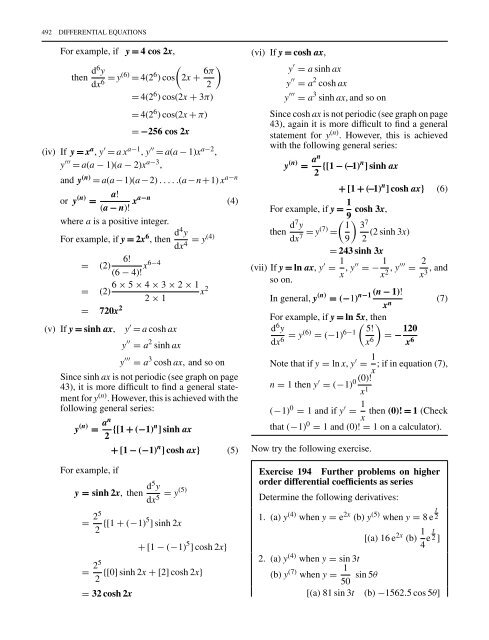differential equation
You also want an ePaper? Increase the reach of your titles
YUMPU automatically turns print PDFs into web optimized ePapers that Google loves.
492 DIFFERENTIAL EQUATIONS<br />
For example, if y = 4 cos 2x,<br />
(<br />
then d6 y<br />
dx 6 = y(6) = 4(2 6 ) cos 2x + 6π )<br />
2<br />
= 4(2 6 ) cos(2x + 3π)<br />
= 4(2 6 ) cos(2x + π)<br />
= −256 cos 2x<br />
(iv) If y = x a , y ′ = ax a−1 , y ′′ = a(a − 1)x a−2 ,<br />
y ′′′ = a(a − 1)(a − 2)x a−3 ,<br />
and y (n) = a(a−1)(a−2) .....(a−n+1) x a−n<br />
or y (n) a!<br />
=<br />
(a − n)! xa−n (4)<br />
where a is a positive integer.<br />
For example, if y = 2x 6 , then d4 y<br />
dx 4 = y(4)<br />
6!<br />
= (2)<br />
(6 − 4)! x6−4<br />
= (2) 6 × 5 × 4 × 3 × 2 × 1<br />
2 × 1<br />
= 720x 2<br />
(v) If y = sinh ax,<br />
y ′ = a cosh ax<br />
y ′′ = a 2 sinh ax<br />
x 2<br />
y ′′′ = a 3 cosh ax, and so on<br />
Since sinh ax is not periodic (see graph on page<br />
43), it is more difficult to find a general statement<br />
for y (n) . However, this is achieved with the<br />
following general series:<br />
y (n) = an<br />
2 {[1 + (−1)n ] sinh ax<br />
For example, if<br />
+ [1 − (−1) n ] cosh ax} (5)<br />
y = sinh 2x, then d5 y<br />
dx 5 = y(5)<br />
= 25<br />
2 {[1 + (−1)5 ] sinh 2x<br />
+ [1 − (−1) 5 ] cosh 2x}<br />
= 25<br />
{[0] sinh 2x + [2] cosh 2x}<br />
2<br />
= 32 cosh 2x<br />
(vi) If y = cosh ax,<br />
y ′ = a sinh ax<br />
y ′′ = a 2 cosh ax<br />
y ′′′ = a 3 sinh ax, and so on<br />
Since cosh ax is not periodic (see graph on page<br />
43), again it is more difficult to find a general<br />
statement for y (n) . However, this is achieved<br />
with the following general series:<br />
y (n) = an<br />
2 {[1 − (−1)n ] sinh ax<br />
+ [1 + (−1) n ] cosh ax} (6)<br />
For example, if y = 1 cosh 3x,<br />
9) then d7 y 1 3<br />
7<br />
=(<br />
dx 7 = y(7) (2 sinh 3x)<br />
9 2<br />
= 243 sinh 3x<br />
(vii) If y = ln ax, y ′ = 1 x , y′′ =− 1 x 2 , y′′′ = 2 x 3 , and<br />
so on.<br />
In general, y (n) n−1 (n − 1)!<br />
= (−1)<br />
x n (7)<br />
For example, if y = ln 5x, then<br />
d 6 ( )<br />
y<br />
5!<br />
dx 6 = y(6) = (−1) 6−1 x 6 = − 120<br />
x 6<br />
Note that if y = ln x, y ′ = 1 ; if in <strong>equation</strong> (7),<br />
x<br />
n = 1 then y ′ = (−1) 0 (0)!<br />
x 1<br />
(−1) 0 = 1 and if y ′ = 1 then (0)! = 1 (Check<br />
x<br />
that (−1) 0 = 1 and (0)! =1 on a calculator).<br />
Now try the following exercise.<br />
Exercise 194 Further problems on higher<br />
order <strong>differential</strong> coefficients as series<br />
Determine the following derivatives:<br />
1. (a) y (4) when y = e 2x (b) y (5) when y = 8e t 2<br />
[(a) 16 e 2x (b) 1 4 e t 2 ]<br />
2. (a) y (4) when y = sin 3t<br />
(b) y (7) when y = 1 sin 5θ<br />
50<br />
[(a) 81 sin 3t (b) −1562.5 cos 5θ]










